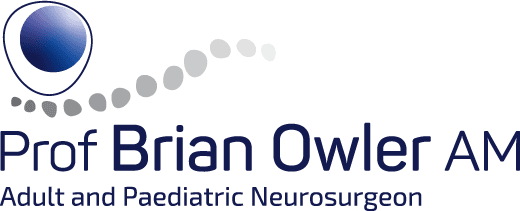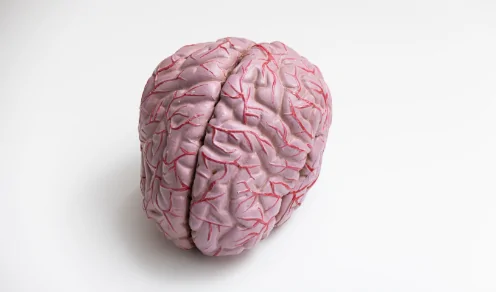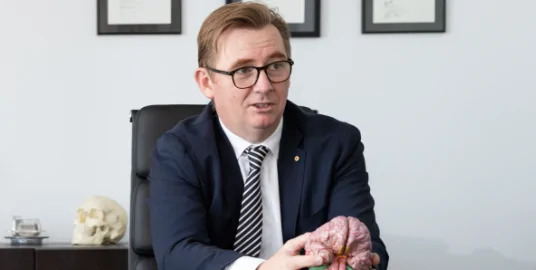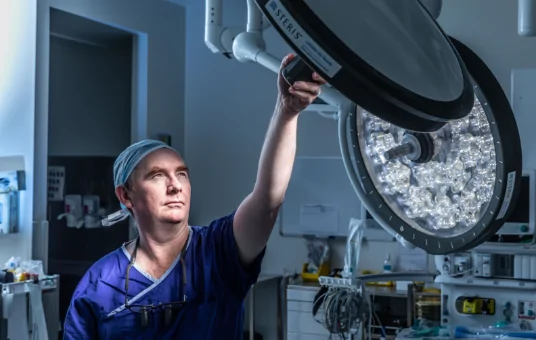



DBS surgery is a complex process. Several steps are involved:
The surgery itself consists of two main sections – inserting the electrodes into the brain (done while the patient is awake) and inserting the ‘pacemaker’ (done with the patient under general anaesthesia).
Once in theatre, the next step is to make the patient comfortable while they are lying on the operating table. The table is padded, and the head of the bed is gently elevated. A pillow is often placed under the knees. The frame, which holds the patient’s head, is attached to the table. The scalp is scrubbed to clean it, and some more local anaesthetic is injected.
During this period the neurologist and neurosurgeon will discuss the scans and finalise the targets on the computer. The DBS target cannot be seen on the CT scan, so we use a computer to carefully align the CT scan with the prior MRI scan. The target can be seen on the MRI, and its location on the CT, so its 3D coordinates in reference to the stereotactic frame can then be calculated. The path that the electrode is to take through the brain will be determined.
Once that process is completed, the main part of the stereotactic frame is set to the desired co-ordinates and connected to the frame that is already attached to the patient. The head is again cleaned with antiseptic solution and drapes are placed around the site for the scalp incision. These are positioned so that the patient can see the other staff in the room and easily communicate with them. Throughout the procedure the anaesthetist will monitor the patient’s condition. The scalp is incised after injecting more local anaesthetic. This is painless although the patient will feel some pushing sensations.
To pass the electrode into the brain a hole, (termed a burr hole), must be placed in the skull on each side. These are normally drilled at this point in the procedure. Again, this part of the procedure is anxiety provoking to most patients. The drill is designed so that it stops as soon as it reached the inside of the skull. Its shape means that it cannot go too far. It is noisy because the sound is transmitted by the skull to the ears. Each hole however takes less than a minute to drill. The anaesthetist often administers some sedation so that the process is tolerated well.
The side of the brain opposite to the side of the body that is most severely affected is operated on first. After drilling the burr hole, the covering of the brain is opened, and a tiny incision is made in the surface of the brain. A cannula, attached to a device called a micro-drive, is carefully introduced into the brain. Through the cannula a very thin electrode is placed into the brain. The micro-drive sits on the stereotactic frame and allows a microelectrode to be advanced through the brain by very small distances at a time. This microelectrode is used to record nerve cell activity, as is travels through an area of the brain. The pattern of nerve cell activity is very helpful to confirm that the electrode is in the correct location. The neurologist may ask you to perform several tasks, such as reaching out, to look for changes in nerve cell activity.
Stimulation, just like the long-term DBS, is then tested using the same microelectrode. This is another tool to ensure that the electrode is well positioned. It is done at several points along the path of the microelectrode. At each point, the stimulation is gradually increased to determine the voltage needed to gain good effects and increased further to find the voltage that causes side effects. We are looking for the site that gives the best effects at low voltage and only causes side effects at high voltages. The neurologist will ask you to perform several tasks to assess the amount of benefit. You will be asked to say when you experience side effects, such as tingling in part of the body, contraction (pulling) of muscles of the face or hand, or double vision. It is important that the stimulation is increased until side effects occur – this is helpful to predict the long-term effects of DBS at that site and to confirm the electrode is well positioned. Some patients find this part of the procedure tiring.
In some cases, the nerve cell recordings do not clearly identify the target or the responses to test stimulation do not show good effects. The microelectrode is then withdrawn and re-inserted in a slightly different location (around 2mm to one side), where it is predicted that better effects can be achieved. This does not involve drilling another burr hole. The nerve cell activity and test stimulation are repeated. In most cases, however excellent results are obtained at the first position.
Once the optimal position has been identified, the microelectrode is removed, and the DBS electrode is inserted at the same location. This is done while using a mobile x-ray machine. It is just one more way to ensure that the electrode is in the correct position within the brain. Once the final position is achieved the electrode is ‘locked’ to the skull using a small plastic cap that sits in the burr hole.
At that point the co-ordinates of the frame are adjusted, and a microelectrode is placed on the other side. Again, the electrical impulses from the neurons are recorded and the results of test stimulation are determined. When the neurologist and neurosurgeon are satisfied with the position, the other DBS electrode is positioned and ‘locked’ onto the skull.
Once both electrodes are in position the wound is closed with some sutures. The frame can then be removed which involves undoing the skull pins. This takes only a few seconds and is painless.
The anaesthetist then puts the patient to sleep under general anaesthesia for the second part of the procedure. Most of the time, this is done immediately after the electrode insertion, but it can be done later.
The time taken to perform the procedure varies from patient to patient, but on average would take around 4 – 5 hours total.
There are significant risks associated with DBS surgery. Prior to surgery patients should consider these risks and their potential consequences before consenting to the procedure. There are risks in relation to the surgery itself, as well as long term adverse effects.
The following is a list of the main issues related to DBS surgery:
The concern of most patients and their doctors is the risk of bleeding within the brain. This is called intracerebral bleeding. In some cases, it can be minor and have no serious effects but in other cases it might cause paralysis of one side of the body, inability to speak, unconsciousness and even death. The risk of serious neurological deficit such as paralysis or death is approximately 2% with an overall risk of some bleeding of approximately 4%.
There is a risk of infection with all operations but those that involve prolonged procedures or implantation of a foreign material such as an electrode or stimulator have a higher rate of infection. While most superficial wound infections can be treated by antibiotics, infections involving the electrodes or stimulator may necessitate removal of these components to allow the infection to clear. Therefore, the procedure may need to be repeated. Steps are taken to reduce the chance of infection including the use of antibiotics during and after the surgery.
Unfortunately, DBS may not achieve the desired or expected benefit. This is very uncommon but can occur.
Despite excellent recordings and responses to test stimulation, it is possible that the final DBS electrode migrates, and the benefit of stimulation can diminish over time. This may require another DBS surgery to re-position the electrode to a better location.
This can be a problem for some patients and may require the temporary use of extra medications. It usually settles within a few days.
The process of DBS surgery causes a “microlesion effect”. There is mild swelling where the electrodes have been, which subsides typically over a few days. The result of this swelling may include involuntary movements (dyskinesias) similar to an excessive dose of PD medication. Although potentially disconcerting, post-operative dyskinesias are not a bad sign.
In some cases, unwanted effects of the stimulation, or poor therapeutic results of stimulation, may reflect incorrect positioning of the electrodes. This may occur even despite all the precautions described earlier in this document. Careful re-programming of the stimulation parameters can generally mean that good benefit is obtained without significant adverse effects.
There is a risk of depression with DBS surgery, but this risk is low. Those with depression prior to surgery may also have an increased risk of depression after surgery. The risk of significant mood disturbance may be about 0.5-2%. Suicide is rare, but the risks increases before as well as after DBS surgery. The reason for this is not clear – it can occur even after excellent improvement with DBS.
Some patients may experience problems with speech and verbal fluency. However, most patients have no alteration of cognition after surgery.
The stimulator is a complex medical device. There is a potential for the device to malfunction. This is very rare but can occur, which results in a sudden worsening of PD symptoms, the same as if the DBS is turned off. In addition, it is possible for the extension leads to fracture. This can occur from repetitive neck movements and may necessitate their replacement. DBS failure can be serious, and you should seek immediate advice from your DBS team if there is a sudden worsening of PD symptoms on one or both sides of the body.
Can occur in the longer term. Treatment may require long term intravenous antibiotics, revision surgery or even removal of the affected hardware.
In some cases, up to 10-20% of people suffer a worsening of speech or balance following DBS. Speech problems are more likely to occur if the speech is already soft and hard to understand, even when medications are working well. Similarly, balance problems are more prone to become worse if there are balance problems or falls, even when the medications are working well. Adjustment of DBS parameters and medications can sometimes be helpful, but speech and balance problems can sometimes remain significant. However, the benefit of DBS on the other aspects of PD means that patients do not ask for the DBS to be turned off because of problems with speech or balance.
It is important to remember that PD is a progressive condition, and the symptoms will worsen slowly with time. DBS does not halt this process but can relieve some of the symptoms. In general, the symptoms that improve with medications also improve with DBS. Over the years, symptoms may occur that do not respond to medications or DBS. This is not because the treatment no longer works but is because the PD has continued to progress. There is no indication that DBS stops working, and there are patients who continue to benefit from DBS more than 10 years later.

The hospital stay is quite variable and depends on the patients’ overall condition prior to surgery and whether the stimulator is programmed while in hospital or afterwards. If the programming occurs after hospital, then patients normally stay around 5 days. During the hospital stay the patient receives daily physiotherapy. Patients will receive prophylactic subcutaneous heparin injections and are required to wear stockings to prevent DVTs. After surgery, there is normally some discomfort around the wound and analgesia is provided. However, the amount of analgesia is required is usually small. Constipation is a common complaint after surgery and is usually due to analgesics. Patients should inform staff if this becomes an issue.
The wound is normally cleaned, and the dressing changed each day. After discharge no dressing is required. You may shower and pat the wound dry with a clean towel afterwards. While the wound may get wet, do not soak it in the bath or in a pool for at least 2 weeks after the surgery. Do not rub the wound. If there are any concerns such as excessive redness, pain or ooze then you should attend your general practitioner as the first step.
Medication adjustment and DBS programming are required frequently in the post-operative period. This begins immediately after surgery. Frequent assessment by the neurologist is required, becoming less frequent as things stabilise after the first few weeks.
For STN DBS, the PD medications are generally reduced to half the usual dosage and adjusted according to the response after that. The dosage is not reduced when the target is the GPi.
The DBS system is checked soon after surgery. It is not turned on until the patient has recovered from the surgery and the “microlesion effect” begins to subside. Most patients have the DBS turned on, and several adjustments made prior to leaving hospital. Ongoing changes are made according to the response. The location of the electrodes on post-operative CT scan helps to choose the best contact for stimulation.
Around 1-2 months after surgery, patients are asked to attend the DBS clinic for a detailed assessment of the effects of DBS. This is generally done after overnight withdrawal of medications. Each of DBS contacts (four on each side, so eight in total) are tested for benefit and side effects. The contact that gives the best effects and fewest side effects is chosen for long-term DBS.
Patients will be given an Access DBS control device, which allows them to turn the DBS system on or off, and to adjust the amount of DBS within pre-specified limits. Your neurologist will show you how to use the Access controller.
An appointment is usually made for the patient to be reviewed by their neurosurgeon around 6 weeks after the surgery.
The stimulator is dependent on a battery. The battery will of course run down over time. The time taken for the battery to run down varies depending on the programming used for stimulation. In most cases the battery will need to be replaced in 3-5 years. Battery replacement is normally straightforward and is performed under general anaesthesia. The old incision on the chest is re-opened, the old stimulator disconnected and removed, the new stimulator is connected and inserted, and the wound closed. The new stimulator is programmed and turned on. The procedure usually takes around 30 minutes.
